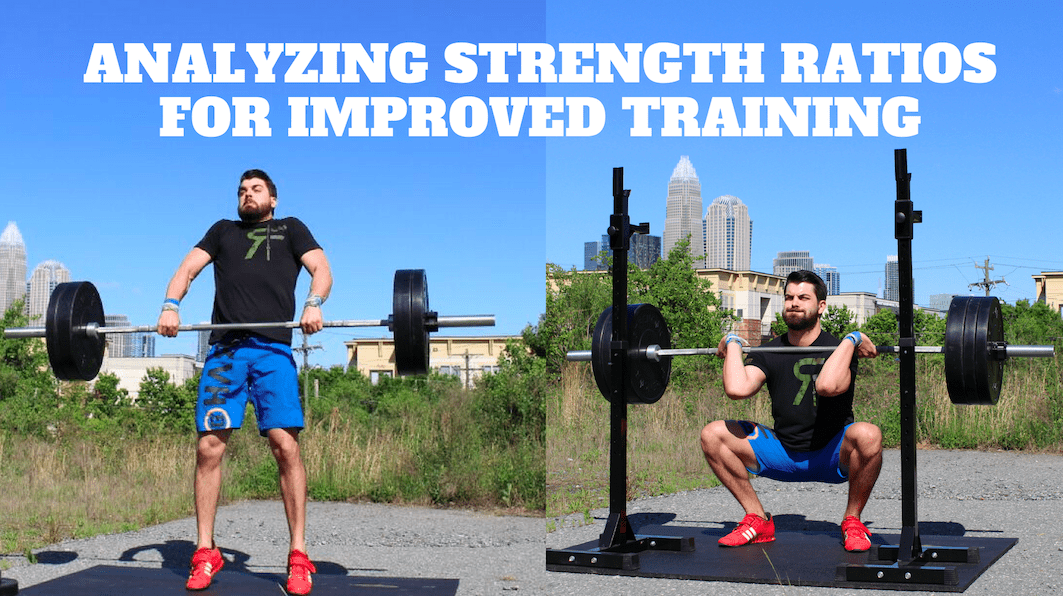No two athletes are the same. And while we believe that in a group training setting all athletes will improve follow the same training, it is important to analyze each athlete individually as well to determine if large individual differences in performance warrants some individualization of programming. For example, if an athlete is working on a goal of performing a 200lb clean but has a 300-pound front squat, we might consider that their Olympic lifting technique should be emphasized more than maximally increasing his or her front squat. By analyzing strength ratios of various exercises, we can get an idea of an athlete’s strengths and weaknesses to better game plan on how to maximize their performance (as it relates to their goals).
I’m excited to be joined by Josh Jeffery of Carolina Performance Training again to discuss the strength ratios he uses to analyze the athletes he works with.
Josh was also nice enough to create a spreadsheet you can quickly use to analyze your strength ratios!
Access our new Weightlifting Ratios Calculator HERE. Simply input your numbers, press the button, and get instant feedback on what lifts you should focus on!
The Author
Be sure to follow Josh Jeffery and Vertex Performance Training. Josh does weekly talks on his Instagram covering topic such as this one that are incredibly valuable for any coach or athlete wanting to improve their fitness. He also does group and custom exercise programming that is as good as anyone’s programming you’ll find!
Strength Ratios Video
Hey, everyone. I’m Josh Jeffery with Carolina Performance Training. Today we’re talking about the assessment of strength ratios. This can be used to determine what to prioritize in my athletes’ training programs.
First, I want to preface this by saying that before you load up anyone in any of these patterns in terms of trying to figure out a one-rep max, which a lot of these are one-rep max tests, make sure to put them through a thorough movement analysis and really assess are they prepared to handle these one-rep max tests? All my athletes go through a movement assessment where I determine they have the range of motion needed for what I’m going to ask them to perform. Then, also, I want to see can they control their body weight and space? Can they control light loads relative to their body weight? Then I get into more of this stuff on the board here. I work primarily with CrossFitters and functional fitness athletes, and this is something I’ve used to really drive their programs.
I have a few things on this far column over here that I’m going to assess relative to their body weight. I think these are really important before I move on to more dynamic movements. For me, I have rear foot elevated split squat up there. I want to see the athlete be able to perform eight reps with a third of their body weight in each hand. If they are a 180-pound individual, I want them to be able to do 8 split squats, rear foot elevated split squats, per leg holding 60 in each hand.
Then, I also will assess weighted pull-ups and weighted dips prior to implementing any kind of kipping variations there, again, just to ensure that we’re preventing injury. We all know the dangers of implementing kipping pull-ups or things like that before someone has a requisite amount of strength, but the same thing can happen, as we saw will all the pec injuries at regionals. I want to make sure that this person really is prepared to start going into these kipping variations of dips as well.
For me, I have a male and female standard. I like all of my male athletes to be able to perform a strict pull-up or a strict dip with 33% of their body weight attached to them as external load. That same 180-pound individual would need to be able to perform a strict pull-up and a strict dip with 60 pounds attached to him. For females, I like to see 20% of their body weight in terms of external load for a weighted pull-up and a weighted dip. If they can pass all of these, I feel a lot more comfortable moving on to either a heavier load or a more dynamic type activity. That’s my first step I like to check.
Lower body and upper assessments
For this lower-body assessment, there are five things that I’m going to look at primarily. The big one is this back squat. That’s going to be my 100%. I’m going to compare everything to that, and that will give me kind of an idea of what I need to prioritize. If my back squat’s 100 for my population that I’m dealing with, I like to see deadlift be more like 125%. If you back squat 200 pounds, I’d like to see a 250-pound deadlift. If you back squat 400, you should be pulling close to 500. For me, that’s a good representation of balance.
Similarly, I compare the back squat and the front squat, and that front squat needs to be about 85% of that back squat. Again, if someone’s deadlift is very close to their back squat, and their front squat is very close to their back squat, that tells me, okay, they might be using the quads really well, but they might struggle when in turns into getting into their posterior chain. Things like looking at these ratios will allow you to determine, okay, what does this athlete need to prioritize? Also, if their front squat is much lower than it needs to be, it might be something to dive into in terms of positioning. It kind of cues you to say, “Okay, I need to look into this.”
I look into power cleans and power snatches, and I also compare them to back squats. The reason I use power cleans and power snatches in terms of this assessment is it takes out some of the complexity of the movement. I don’t want this ratio to be skewed because someone’s technique isn’t great. That’s a whole nother assessment when we’re looking at their efficiency of their Olympic lifting technique. This is simply to determine where the athlete sits on a strength to speed continuum, how well their absolute strength is versus their hip speed.
I’d like to see two-thirds of their back squat as a power clean, and I want them to power snatch at least half their back squat, so I put 51% up here. If someone’s power clean is 80%, and their power snatch is 70% of their back squat, that tells me why this person probably needs to get stronger. Then, also, on the other hand, if their power snatch is 40%, and they’re barely cleaning half their back squat, that tells me, okay, this person might have a good amount of absolute strength, but you would need to address technique or be able to try to make him a little bit more explosive. That’s kind of a quick little lower-body assessment that I’ll do with my athletes.
Vertical Pushing and Pulling
Then I move into more of this upper-body assessment. In terms of vertical pushing and pulling, I compare a weighted pull-up and the strict press. Now, the weighted pull-up, I use kind of a global vertical pulling number here, so body weight plus external load, and then strict press is just a standing strict shoulder press, and I like to compare these. Whatever your weighted pull-up is, that total score, I like to see a press of about 65%. You’ll often see a big discrepancy here, and it will let you know if you need to focus more on pushing or pulling in your program.
We also like to test close-grip bench press. It seems to me that, oftentimes, you’ll see a close-grip bench that’s very close to a weighted pull-up in someone that’s balanced, and believe it or not, you also see a close-grip bench that’s very close to a power clean. Again, that’s kind of a ratio that’s a little unexpected, but for me, the main reason I’m testing close-grip bench is to get some other assessments from it.
While I have this strength ratio, the weighted pull-up and the strict press, 100 and 65%, I set a new 100% for my close-grip bench to assess a couple other things, first being a seated dumbbell shoulder press. This, the athlete’s sitting down. They’re starting with more of a neutral grip, and they finish with a little bit of pronation at the top, so they end up being at the top with a little bit internal rotation, I should say. That, I want to see 30% of their close-grip bench in each hand. Again, I tested with this rear foot split squat a little bit of their unilateral lower-body strength, but then when I moved to this strict press, it’s a little bit of unilateral upper-body strength. Seated dumbbell press, I like to see where that sits relative to the close-grip bench press.
Then, also, I do some tests to assess some strength of, say, the muscles that control your [scap 00:06:23]. I test a seated dumbbell external rotation, a Powell raise, which is sideline straight arm, then a trap three, which is a little bit leaning forward, having the support forward, and you’re kind of in that scaption plane. I test all of these, and I’d like to see someone be able to perform 6 repetitions with 10% of their close-grip bench max. That may seem a little bit high, but for me, I really like to look at the strength of those muscles to ensure that they can really control movement of that scap when I’m going to be putting a ton of demand in terms of high volumes and repetitions and more dynamic repetitions in this population. Also, these metrics are here are not one-rep max. We have six when it comes to the seated dumbbell press, and then we also have … again, that’s two arms, and then these scap tests here are eight reps on each arm. Again, those are percentages off your close-grip bench press.
Again, this very short, quick. You can have your athlete complete this over a few days, depending on how you structure it, and it allows you to determine what kind of things you need to prioritize initially when you’re designing a training program.






